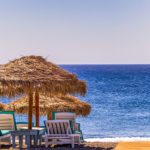The area: Neos Marmaras, Sithonia, Halkidiki

The “Dragoudeli” forest
On the peninsula of Sithonia, just 5 km from the seaside settlement of Neos Marmaras and the large hotel unit of “Porto Carras”, is located the forest “Dragoundeli”, an area of 16,570 hectares. Its northern, eastern and western sides border with monastic, community and private fields, while on the south border on a public pasture. It is part of the complex of forests of Sithonia and occupies the western and northern central part of the mountain complex “Longos” of the peninsula, which is a continuation of Mount Cholion.
On its outskirts, at the southwestern end and an altitude of 250m, is the traditional settlement of the Parthenon, where in the last decade, after a long period of abandonment by the inhabitants, who lived there permanently, life is restored. The settlement has developed into a summer and winter tourist destination. A significant number of visitors are recorded seeking enjoyment into the forest landscape and related activities, such as walks, cycling, jogging, picnics and camping. The places that attract more visitors are the place “Psaria” and the small church of Profitis Ilias on the east side.
Since 1960, during the summer months, there has been intense activity in the coastal zone of the area, known for the natural beauty of its coasts.
Neos Marmaras
Neos Marmaras, on the western middle of the Sithonia peninsula in the prefecture of Halkidiki, was built on August 1, 1924 by refugees, originating from the island of Marmaras in Propontis, on three hills, in the mountain range Itamos or Dragoudelis. The rocky area was then the Balabani metochi of the Monastery of Gregory of Mount Athos. Today it is one of the most beautiful areas in Halkidiki. Until the end of the 60’s, several inhabitants from the neighboring, Traditional Byzantine Settlement, Parthenon, settled there. Its inhabitants are engaged in tourism, agriculture, cultivating olive trees and vines, but also fishing. The area does not only produce oil, but honey too, while many residents are engaged in hunting.
At a distance of 125 km from the city of Thessaloniki, the seaside Neos Marmaras becomes every year a pole of attraction for many tourists, combining mountain and sea. Hundreds of boats are housed in the marina of the famous Porto Carras complex and the floating port of Marmara.
The tourist development of Neos Marmaras dates back to the early 1970s, when the construction of the large tourist complex with the special architectural form of the time “Porto Carras” began. One of the most cosmopolitan areas of Sithonia, Neos Marmaras combines the sea with the green, beautiful landscapes and tourist infrastructure with special possibilities for accommodation, gastronomy and entertainment.
Built amphitheatrical on four bays, where the old fish taverns, the restaurants and the cafes serve their customers with tables up to the seashore. On an imposing hill dominates the beautiful church of Taxiarches, dates from 1937. In the fourth bay, the large sandy beach of Neos Marmaras, is surrounded by fish taverns and beach-bars.
Opposite Neos Marmaras, the islet “Kelyfos” or “Turtle” got its name from its shape that looks like a turtle shell. It has steep slopes with wild olive trees, pines, while on its rocks one can see wild rabbits and goats. A boat from the port can transport tourists combining visiting with swimming in the clear blue waters.
The Parthenon
The settlement of the Parthenon has been mentioned since the 10th century with the names Parthenopolis, Partheni and Parthenionas. During the Ottoman rule, it belonged administratively to the nahiyye of Pazarkhiah and fiscally to the hash of Loggos. During the revolution of 1821 many inhabitants took an active role in the various battles. In 1970 the village was abandoned and its inhabitants naturalized in Neos Marmaras.
The Parthenon at a distance of five kilometers from Neos Marmaras and at an altitude of 350 meters dominates the western foothills of Itamos. It has been declared a traditional settlement and its narrow streets and stone houses are built amphitheatrical in a green landscape. There are taverns and hostels, while the old primary school houses a folklore museum. The surrounding paths lead to the slopes of Itamos.

 Previous Post
Previous Post